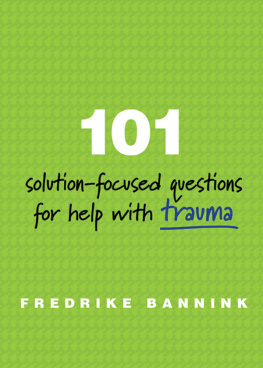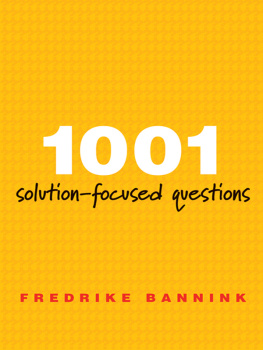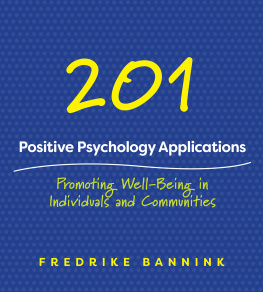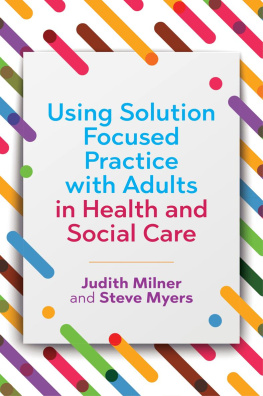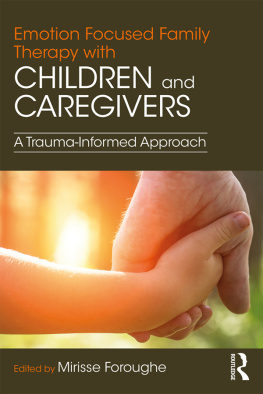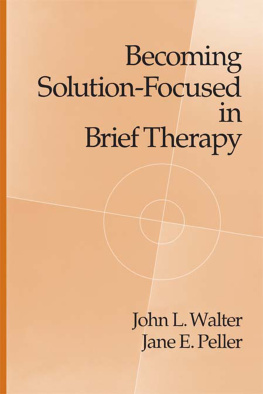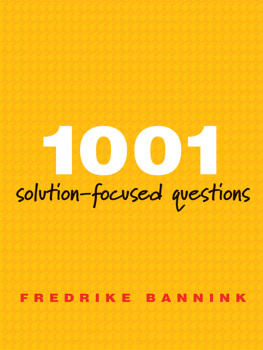Fredrike Bannink - 101 Solution-Focused Questions for Help with Trauma
Here you can read online Fredrike Bannink - 101 Solution-Focused Questions for Help with Trauma full text of the book (entire story) in english for free. Download pdf and epub, get meaning, cover and reviews about this ebook. year: 2018, genre: Romance novel. Description of the work, (preface) as well as reviews are available. Best literature library LitArk.com created for fans of good reading and offers a wide selection of genres:
Romance novel
Science fiction
Adventure
Detective
Science
History
Home and family
Prose
Art
Politics
Computer
Non-fiction
Religion
Business
Children
Humor
Choose a favorite category and find really read worthwhile books. Enjoy immersion in the world of imagination, feel the emotions of the characters or learn something new for yourself, make an fascinating discovery.
- Book:101 Solution-Focused Questions for Help with Trauma
- Author:
- Genre:
- Year:2018
- Rating:3 / 5
- Favourites:Add to favourites
- Your mark:
- 60
- 1
- 2
- 3
- 4
- 5
101 Solution-Focused Questions for Help with Trauma: summary, description and annotation
We offer to read an annotation, description, summary or preface (depends on what the author of the book "101 Solution-Focused Questions for Help with Trauma" wrote himself). If you haven't found the necessary information about the book — write in the comments, we will try to find it.
Fredrike Bannink: author's other books
Who wrote 101 Solution-Focused Questions for Help with Trauma? Find out the surname, the name of the author of the book and a list of all author's works by series.
101 Solution-Focused Questions for Help with Trauma — read online for free the complete book (whole text) full work
Below is the text of the book, divided by pages. System saving the place of the last page read, allows you to conveniently read the book "101 Solution-Focused Questions for Help with Trauma" online for free, without having to search again every time where you left off. Put a bookmark, and you can go to the page where you finished reading at any time.
Font size:
Interval:
Bookmark:
T H E 1 0 1 S O L U T I O N - F O C U S E D Q U E S T I O N S
S E R I E S O F B O O K S B Y
F R E D R I K E B A N N I N K
101 Solution-Focused Questions for Help with Anxiety
101 Solution-Focused Questions for Help with Depression
101 Solution-Focused Questions for Help with Trauma
Books available
separately or as a set.
101 Solution-Focused Questions for Help with Trauma
Copyright 2015 by Fredrike Bannink
All rights reserved
First Edition
For information about permission to reproduce selections from this book,
write to Permissions, W. W. Norton & Company, Inc.,
500 Fifth Avenue, New York, NY 10110
For information about special discounts for bulk purchases, please contact
W. W. Norton Special Sales at specialsales@wwnorton.com or 800-233-4830
Book design by Molly Heron
Production manager: Christine Critelli
The Library of Congress has cataloged the printed edition as follows:
Bannink, Fredrike.
101 solution-focused questions for help with trauma / Fredrike Bannink.
First edition.
pages cm. (A Norton professional book)
Includes bibliographical references and index.
ISBN 978-0-393-71112-7 (pbk.)
1. Post-traumatic stress disorderTreatmentMiscellanea.
2.Solution-focused brief therapy. I. Title. II. Title: One hundred one
solution-focused questions for help with trauma. III. Title: One hundred
and one solution-focused questions for help with trauma.
RC552.P67B334 2015
616.8521dc23
2015023989
ISBN 978-0-393-71112-7 (pbk.)
ISBN 978-0-393-71113-4 (e-book)
W. W. Norton & Company, Inc.
500 Fifth Avenue, New York, N.Y. 10110
www. wwnorton.com
W. W. Norton & Company Ltd.
Castle House, 75/76 Wells Street, London W1T 3QT
I am not what happened to me.
I am what I choose to become.
Jungs (1965) quote
will be the theme
of this book.
Contents
6Finding Competence
9Reflection and Feedback
According to Steve De Shazer, one of the founders of solution-focused brief therapy, differences in and of themselves are just differences. But some people (and some animals) have made a difference that has been significant in my life and my work. In one way or another, they all assisted me in writing these volumes.
I thank my colleagues, students, and above all my clients, who have helped me discover, apply, and improve my work over the years. I thank my publisher, Deborah Malmud, for her invitation to write these volumes; my friend and colleague Suzanne Aldis Routh for translating; and my colleague Kaz de Jong for reviewing this book.
To my husband, I am grateful for your continuing love and support. To my four Italian cats, mille grazie for keeping me company during the many pleasant hours of writing.
T his is a book to help clients use what happened to them to make their lives better instead of bitter . In psychotherapy with trauma survivors, there can be a range of outcomes. For some, there is full or partial recovery from symptoms of PTSD, and that is as far as these clients can go. For others, there is not only recovery from symptoms but also posttraumatic growth. For some people, the outcome involves finding a resiliency that allows them to go on with their lives.
This book aims to help clients struggling with trauma by being first and foremost a practical book aimed at all professionals working with trauma survivors, offering them solution-focused (SF) viewpoints and skills. The book invites them to change their focus from what is wrong to what is right with their clients and from what isnt working to what is working in their lives.
Traditional psychotherapy has been strongly influenced by the medical model. The structure of problem-solvingfirst determining the nature of the problem and then intervening to minimize sufferinginfluences the content of the interaction between therapists and clients; the focus is on pathology. However, it is not this negative way of thinking but clients strengths, competencies, and resources that are most important in bringing about positive change. The secret of change is to focus all energy not on fighting the old, but on building the new.
This is Volume 3 of a series of three books, each offering 101 solution-focused questions for help with a specific psychiatric disorder: anxiety (Volume 1), depression (Volume 2), or trauma (this volume). The serieswhich may in the future include more titlesis based on my book 1001 Solution-Focused Questions: Handbook for Solution-Focused Interviewing (Bannink, 2010a), originally written in Dutch and translated into English, German, and Korean.
I feel privileged that Insoo Kim Berg, co-founder of solution-focused brief therapy (SFBT), wrote the Foreword of 1001 Solution-Focused Questions in 2006:
SFBT is based on the respectful assumption that clients have the inner resources to construct highly individualized and uniquely effective solutions to their problems . .. The 1001 SF questions presented in this clear and well-written book will give the reader a very good idea of the importance of the precise use of language as a tool in SFBT. Readers are invited to open themselves to a new light on interviewing clients.
The focus in each volume is on creating preferred futures and the pathways to get there. In addition to a description of the ways in which SFBT may be applied, each book contains exactly 101 SF questions that lie at the heart of SFBT. Over the years, I have collected more than 2,000 SF questions. It has been quite a challenge to select what I think are the best 101 questions for each volume. I admit I cheated a little by sometimes grouping multiple questions together and by changing some questions to the first person (n this volume, only questions therapists ask their clients are counted). As a result, you actually get far more than 101 questions! Questions for therapists themselves and questions clients may ask themselves (sometimes invited by their therapists) or may ask their therapists are also described, but are not included in the 101 list. At the end of each chapter, an overview of the SF questions is given. Some of the questions overlap with those in other chapters. Rather than repeating these questions, I have chosen to mention each SF question just once.
SFBT is a transdiagnostic approach. The reason I have nevertheless written separate volumes for different psychiatric disorders is to accommodate the many colleagues who are working with specific client groups. To give readers the opportunity to integrate the SF approach, this book introduces 40 exercises, 25 cases, and 18 stories.
This volume is aimed at all professionals working with trauma survivors, as well as their families and friends, who would prefer to adopt a (more) positive approach and/or would like to simply increase the range of techniques available to them. SF conversations with clients have proven to be more lighthearted than other kinds of conversations, ensuring less burnout for professionals.
Although the book is primarily aimed at professionals, I hope that people suffering from PTSD who dont see a therapist may also find useful information and helpful exercises within its pages.
Its about time to turn the tide on trauma treatment and shift the focus from reducing distress and merely surviving to building success and positively thriving.
Fredrike Bannink
December 2014
The medical model uses the term patient ; SFBT uses the term client .
T rauma (from the Greek word meaning a wound) refers to either a physical injury or psychological shock or severe distress resulting from a traumatic experience. Psychological trauma is part of being human. Even so, most people dont develop posttraumatic stress disorder (PTSD). Epidemiological studies of the prevalence of PTSD in trauma-exposed populations show that resilience is the norm, not the exception. In this chapter, a short description of PTSD is given, followed by myths about trauma. My concept of posttraumatic success includes the 3 Rs: R ecovery, en R ichment (posttraumatic growth), and R esilience. Understanding clients resources helps therapists foster positive development as opposed to focusing on what is wrong with them, and to enable them to use what happened to them to make their lives better instead of bitter .
Next pageFont size:
Interval:
Bookmark:
Similar books «101 Solution-Focused Questions for Help with Trauma»
Look at similar books to 101 Solution-Focused Questions for Help with Trauma. We have selected literature similar in name and meaning in the hope of providing readers with more options to find new, interesting, not yet read works.
Discussion, reviews of the book 101 Solution-Focused Questions for Help with Trauma and just readers' own opinions. Leave your comments, write what you think about the work, its meaning or the main characters. Specify what exactly you liked and what you didn't like, and why you think so.

